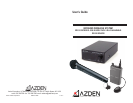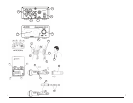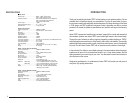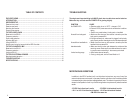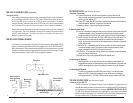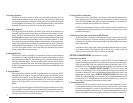
4
1
RECEIVER SETUP (see illustration on page i)
I. Receiver Front Panel
A. Power-Volume Knob - turn the knob clockwise to turn the receiver ON
and to increase the output volume level. Turn the knob counter-clockwise until it
clicks to turn the receiver OFF.
B. Power LED - when the LED turns Red it indicates the receiver is ON and Green
when the receiver “receives” a signal from a transmitter.
C. Receiving Sensor - internal receiving infrared sensor
II. Receiver Rear Panel
D. Line Out - connects the receiver to the line or aux input of a mixer, audio amplifier
or powered speaker. Note: The sound from the microphone and any audio
player connected to the LINE-IN, will output on both the Left and Right channel.
E. Line In - connect the output of a CD, Tape or MP3 player to this input. Note: The
front panel volume control will not change the volume level of the connected
player. Use the volume control of the connected player to increase or decrease
its own volume level.
F: Mic Level Out - connects the receiver to the mic input of a mixer, audio amplifier
or powered speaker. Note: The sound from the microphone and any audio
player connected to the LINE-IN, will output at mic level.
G: Ext Sensor - To increase the working distance of the system, an optional external
sensor can be connected here.
H: Power Input - plug in the supplied BC-26U AC adapter here.
III. Mounting the Receiver
Infrared operates “line-of-sight” and can be interrupted by a solid object. It is
suggested the receiver (or external sensor) be mounted/placed in a location that
puts the receiving sensors above the audience’s head or any other obstacles.
IV. Powering the Receiver
The IRR-15 is powered by the BC-26U power supply. Connect the power
supply to the IRR-15 and plug the adapter into an active wall socket before
turning the receiver On. DO NOT USE any power supply except the BC-26U.
THE IRB-10 BODY-PACK (see illustration on page i)
I. Batteries for the IRB-10:
The IRB-10 uses two “AA” batteries for power. They are placed in the battery compart-
ment (S). After sliding the battery compartment door off, carefully place FRESH batteries in
the compartment in the directions shown on the sticker. OBSERVE PROPER POLARITY!
The IRB-10 can use either Alkaline, Ni-Cd or Ni-MH batteries. In the case of rechargeable
batteries, be sure that they are FULLY CHARGED before use. Battery life depends on (1)
the type of battery used, (2) the power mode chosen and other factors.
THE IRH-10 HANDHELD MIC (continued )
I. Using the IRH-10:
After installing fresh batteries and choosing a frequency, simply turn the mic/transmit-
ter on by sliding the ON/OFF switch up. The Power LED above the switch will glow as
will the red LED on the front panel of the IRR-20 which corresponds to the chosen
channel. Be sure to slide the Power Switch to OFF when not in use to preserve battery
life. The Power LED on the mic will turn from green to red to indicate “Low Battery”.
Best performance is achieved when the mic is held close to the mouth and one speaks
in a normal tone. The mic is designed to be held in the middle of the handle with the
ON/OFF switch facing you. This allows the emitters at the base and near the mic
element to operate at their peak.
THE IRD-30 EXTERNAL SENSOR
To increase the working range of the system, an external sensor can be added. IRD-30
sensor is powered by the receiver and can be plugged into the “EXT. SENSOR INPUT”
(G) on the rear panel. With an external sensor attached, if the front panel sensor is blocked
(perhaps in a secured cabinet or closet) the external sensor will pick-up the signal . Follow
the illustrations below to install the IRD-30 mounting plate and sensor.
Bend here
Mounting holes
Hold bracket in
place and bend
up to 90
o
1
st
2
nd
3
rd
4
th
Mount with
2 screws
Bend up to
desired angle
Attach IRD-30
on bracket



